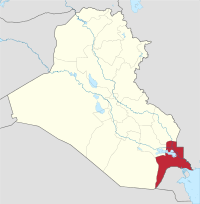Basra Governorate
| Basra Governorate محافظة البصرة Basra Province | |||
|---|---|---|---|
| Governorate | |||
| |||
 | |||
| Coordinates: 30°22′N 47°22′E / 30.367°N 47.367°ECoordinates: 30°22′N 47°22′E / 30.367°N 47.367°E | |||
| Country |
| ||
| Capital | Basra | ||
| Area | |||
| • Total | 19,070 km2 (7,360 sq mi) | ||
| Population (2011 Estimate) | |||
| • Total | 4,700,000 | ||
| Website | basrahgov.com | ||
Basra Governorate (Arabic: محافظة البصرة Muḥāfaẓa al-Baṣra) (or Basra Province) is a governorate in southern Iraq, bordering Kuwait to the south and Iran to the east. The capital is the city of Basra. Other districts of Basra include Al-Qurnah, Az Zubayr, Al Midaina, Shatt Al Arab, Abu Al Khaseeb and Al Faw located on the Persian Gulf.
History

In 1920, after the defeat of the Ottoman Empire in World War I, the United Kingdom took over the former Ottoman vilayets of Basra, Baghdad and Mosul which had together formed the historical region of Irak Arabi or Irak Babeli, and called it the British Mandate of Mesopotamia. The mandate was succeeded by the Kingdom of Iraq in 1932.[1]
The Shiite population suffered long and hard under Saddam's rule. The city of Basra had suffered considerably during the eight-year war with Iran and Allied bombardment and in 1991 during the Gulf War, the governorate ventured into an uprising after the United States promised them aid. It was started in Basra by angry soldiers, according to popular legend after they fired at a giant public portrait of Saddam Hussein.[2] Mass support on the streets followed, shouting slogans, executing Ba'ath party members, leaders and secret police, and destroying pictures and monuments of Saddam Hussein. The participants had expected support from American troops. but the Allied army at the time was occupied despite the 24th Infantry Division stationed only several miles from the city. The city of Basra didn't completely succumb to the rebels; a counterattack by some 6,000 loyalists from the Republican Guard held out against 5,000 defectors of the Iraqi army.[2] After about three days, the Republican Guard began to gain control, destroying "everything in front of them", killing many of the rebels in the streets and conducting mass executions on the public squares.[2]
From 2003 the governorate was one of the centres of warfare during the invasion of the British and Americans during the Iraq War. The Battle of Basra took place between March 23 and April 7 between the British 1st Armoured Division forces under Major General Robin Brims, and Iraqi forces under General Ali Hassan al-Majid (Chemical Ali).[3] Much of the heaviest combat in the war took place in the province in subsequent weeks. Several outbreaks of violence between secular Iraqis and Shiite Muslims broke out in summer 2006, and in September 2007, British troops were withdrawn to Basra Airport, and withdrew entirely from the city in December 2007.[3] Following the example of the Kurdistan Autonomous Region in northern Iraq, Basra has proposed uniting with the other provinces of Dhi Qar and Maysan as an autonomous region. On October 15, 2005, 691,024 people, some 96.02%, voted for the new constitution.
Government
- Governor: Majid al Nasrawi
- Deputy Governor: Mohammed Tahir
- Provincial Council Chairman (PCC): Khalaf Abdul al Samad
Districts
See also
References
- ↑ Sassoon, Joseph (12 December 2011). Saddam Hussein's Ba'th Party: Inside an Authoritarian Regime. Cambridge University Press. p. 17. ISBN 978-1-139-50392-1.
- 1 2 3 Goldstein, Eric (1 January 1992). Endless Torment: The 1991 Uprising in Iraq and Its Aftermath. Human Rights Watch. p. 45. ISBN 978-1-56432-069-8.
- 1 2 Mockaitis, Thomas R. (15 August 2013). The Iraq War Encyclopedia. ABC-CLIO. p. 50. ISBN 978-0-313-38063-1.
 |
Dhi Qar Governorate | Maysan Governorate |  | |
| Al Muthanna Governorate | |
| ||
| ||||
| | ||||
| |
Persian Gulf |

